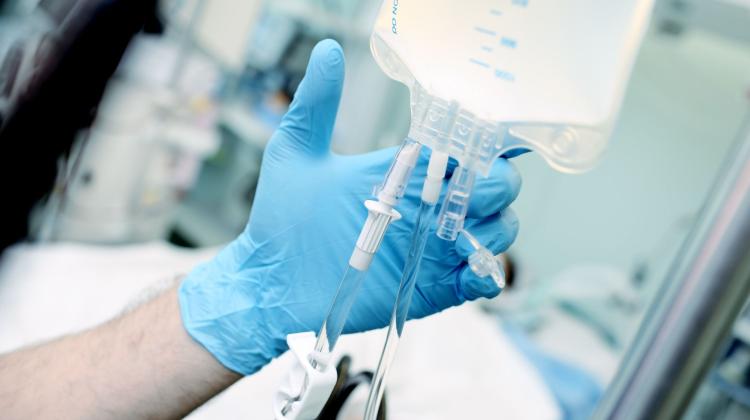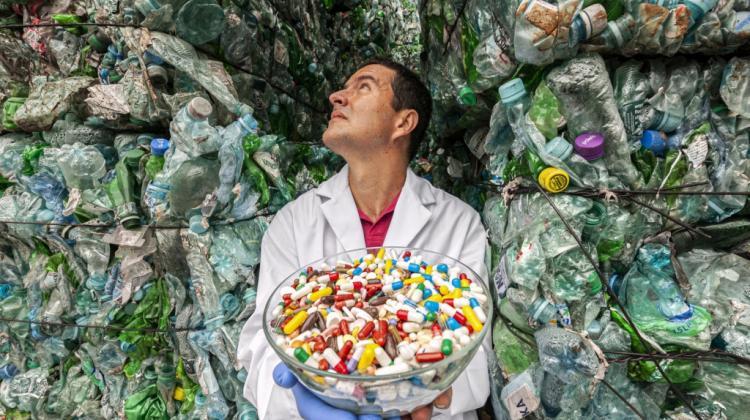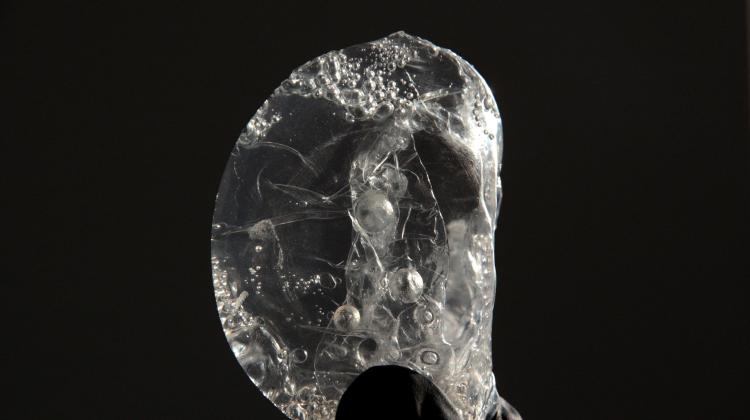Scientists to tackle single-use medical devices and packaging waste
 Credit: Adobe Stock
Credit: Adobe Stock
One hospital bed generates around 3 kg of plastic waste per day. To make hospitals 'greener', an international consortium coordinated by a Polish university is developing a technology for producing 'plant-based' polymers. They will be used to produce biodegradable medical packaging materials for disposable products.
GREEN-MAP is a European research project which aims to develop green polymers and thus create the right conditions for a circular economy in the single-use medical device industry. The project, financed with EU funds, is implemented by a consortium coordinated by the West Pomeranian University of Technology in Szczecin. The remaining consortium members are: the University of Bologna (Italy), the Centre of Polymer and Carbon Materials of the Polish Academy of Sciences in Zabrze, the Budapest University of Technology and Economics (Hungary), companies from Italy, Germany, the Netherlands and Poland, and one research partner from the USA.
“The fact that a Polish organisation is the coordinator of such a large, international project does not happen often,” said the main coordinator of GREEN-MAP, Professor Mirosława El Fray from the Department of Polymer Engineering and Biomaterials, Faculty of Technology and Chemical Engineering of the West Pomeranian University of Technology in Szczecin.
The researcher explains that right now, initiatives such as the 'Green Deal', all green technologies, sustainable economy, are worth focusing on and investing in. Science knows it, industry knows it. One of the areas where there is still much to do are medical facilities, mainly hospitals, where due to the need to use disposable, sterile, properly packed equipment and materials, the amount of plastic waste is huge.
Professor El Fray said: “In order to make hospitals a little more friendly to the planet, we decided to develop biodegradable materials for the medical industry. Currently, the packaging materials for medical devices are made of polymers, mainly polyolefins, i.e. petroleum derivatives. We want to develop polymers made from renewable raw materials, i.e. plants. As a result, we will be able to offer the medical industry disposable packaging that will be biodegradable when it ends up in municipal waste or compost.”
She added that through the action of water, light and microorganisms, such green polymers decompose quickly and easily, which is not true for petroleum-derived polymers. She said: “We, as chemists, guarantee that these materials will be completely degraded within 3-6 months.”
ONE PATIENT IS THREE KILOGRAMS OF PLASTIC WASTE PER DAY
Especially during the pandemic, it became evident that the problem of disposable medical products and their packaging is huge.
Professor EI Fray said: “It is waste with which we cannot do anything. Up to three kilograms of plastic are generated by one patient's bed every day!
“This includes packaging from syringes, aprons, spatulas, etc. This type of waste is not contaminated, so it is not sent for special disposal, i.e. incineration. It's just garbage that ends up in a landfill.”
An alternative are green polymers produced from plant raw materials, such as corn, rapeseed and other oilseeds. After special processing, oils obtained from them can be used as substrates for creating new, biodegradable materials.
The technology used to produce polymers from green raw materials is the same as for traditional polymers. The only difference are the reaction components.
EI Fray said: “However, the production process can take place on the same devices, in the same machine park as the production of the popular PET, i.e. plastic bottles that litter our planet.
“This is a huge advantage when it comes to the possibility of easy and cheap implementation of green polymers. The industry will not have to switch to a completely different, unknown process. In addition to ecological considerations, it will also be economically viable.”
Significant increases in crude oil prices may also translate into the popularity of ecological polymers. Until now, the petrochemical raw materials used to produce traditional polymers were very cheap. After the outbreak of war in Ukraine, their prices skyrocketed, making green raw materials competitive in terms of prices. This is a very important factor, as prices are the main barrier for new materials entering the market.
POLYMER LIFE CYCLE
The idea of the GREEN-MAP consortium is to combine the efforts of science and industry in the implementation of the green polymer idea: one of the partners (a company from the Netherlands) produces green raw materials, other centres test them in their laboratories and try to develop new materials from them (the West Pomeranian University of Technology in Szczecin). Other consortium members evaluate the properties of finished polymers, their susceptibility to degradation, etc. (University of Bologna, Ohio State University in the USA and an institute of the Polish Academy of Sciences). The last stage is processing (the centre in Budapest and industrial partners in Germany and Poland).
Professor EI Ray said: “Before we obtain the finished product, the packaging, a full production cycle must take place. Our unit is crucial in this process because we synthesise new materials. We have the ability of producing kilogram quantities of polymeric materials, which is a great achievement in the world of science.
“Finished products are subjected to the life cycle analysis. It is a very important part of the circular economy. This includes calculating the amount of energy used in the production of the material and its carbon footprint. ‘
“This is an extremely important aspect, because it shows us whether the technologies we are developing are really better for the environment than traditional ones. After all, we wouldn't want it to be art for art's sake, something that is only 'green' in name only, and burdens the environment as much or even more than the currently used methods.”
The approach to the synthesis of materials, invented by the scientists from the West Pomeranian University of Technology, is also original. Enzymes are used as reaction catalysts. “This makes the whole process even greener, because both raw materials and catalysts are natural,” El Fray said.
She added that individual elements of the technology are at the stage of patent applications.
PACKAGING WITH ANTIMICROBIAL PROPERTIES
The second unit of the West Pomeranian University of Technology that participates in the consortium's work is the Centre of Bioimmobilisation and Innovative Packaging Materials. Its employees ensure and determine the potential antimicrobial properties of green polymers.
Such properties can be obtained in two ways: either by adding biocidal substances that inhibit the growth of bacteria to the product, or by modifying the structure of the polymers themselves to make them more resistant to colonization by pathogens.
Expert Dr. Łukasz Łopusiewicz said: “To put it simply: we want to support the fight against nosocomial infections. In recent years, they have become an increasingly serious problem. As a result of overuse of antibiotics, antibiotic-resistant strains of bacteria have appeared in the world. Their presence in the hospital environment can cause various infections, including fatal ones.”
He added: “We would like our materials to be in line with the green deal, but also help prevent nosocomial infections. One of the key elements here is to maintain the sterility of medical devices, but it is not only about the sterility of the equipment itself, but also its packaging. This is referred to as a sterile barrier system (SBS).”
The scientist explains that after washing and decontamination, each medical tool must be placed in SBS, which provides a microbiological barrier and sterility during storage. Thus, the safety of all persons participating in the medical procedure is guaranteed: from doctors and nurses to patients.
Łopusiewicz said: “We are trying to strengthen this system in various ways. In addition to adding biocidal substances, we try to modify packaging materials, for example by adding fatty acids, to change their surface properties towards more hydrophobic ones. Thanks to this, it is more difficult for bacteria to attach to such a surface and form a biofilm (biological membrane composed of many layers of bacteria and substances produced by them - ed. PAP).
“Biofilms are often the most resistant to drugs and preventing their formation is crucial. Biofilms are associated with dangerous infections with Staphylococcus aureus, Pseudomonas aeruginosa, Escherichia coli, etc.
“Our goal is for the packaging of disposable medical devices to interact with pathogens present in the hospital environment, and thus protect the patient's body against infection.”
He added that while being deadly to bacteria and fungi in hospital conditions, green packaging materials will not harm the environment. Those intended for composting will not block the natural decomposition processes carried out by bacteria.
***
The GREEN-MAP project is now halfway through, but the results scientists have obtained so far are very promising.
Professor EI Fray said: “Green polymers are the materials of the future. I believe that they will be used not only in the medical sector, although for now we are focusing on this.
“There is so much waste generated by medical devices that something needs to be done about it. We need to look for alternatives, otherwise plastic will completely litter our planet'. (PAP)
PAP - Science in Poland, Katarzyna Czechowicz
kap/ agt/ kap/
tr. RL
Przed dodaniem komentarza prosimy o zapoznanie z Regulaminem forum serwisu Nauka w Polsce.



















